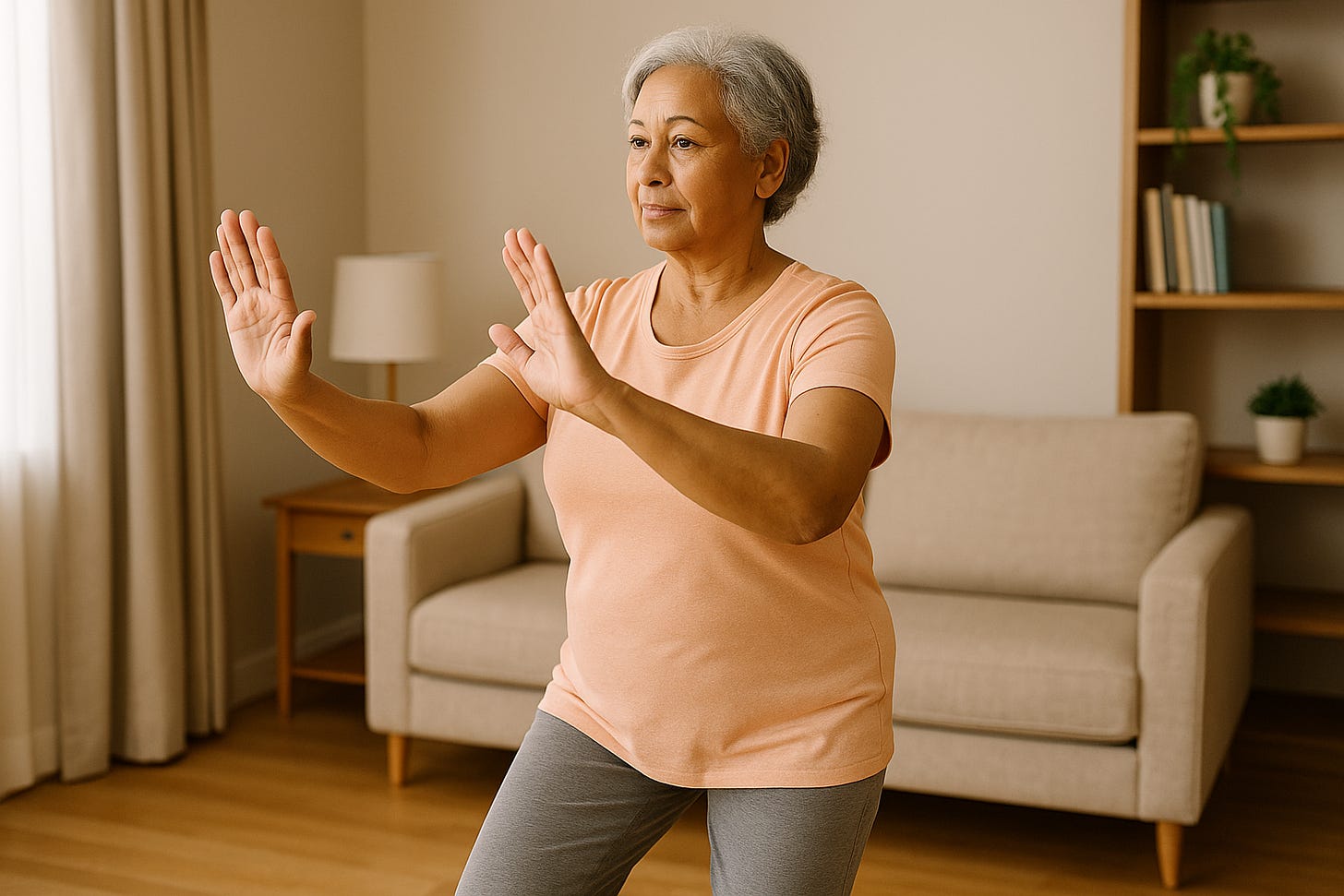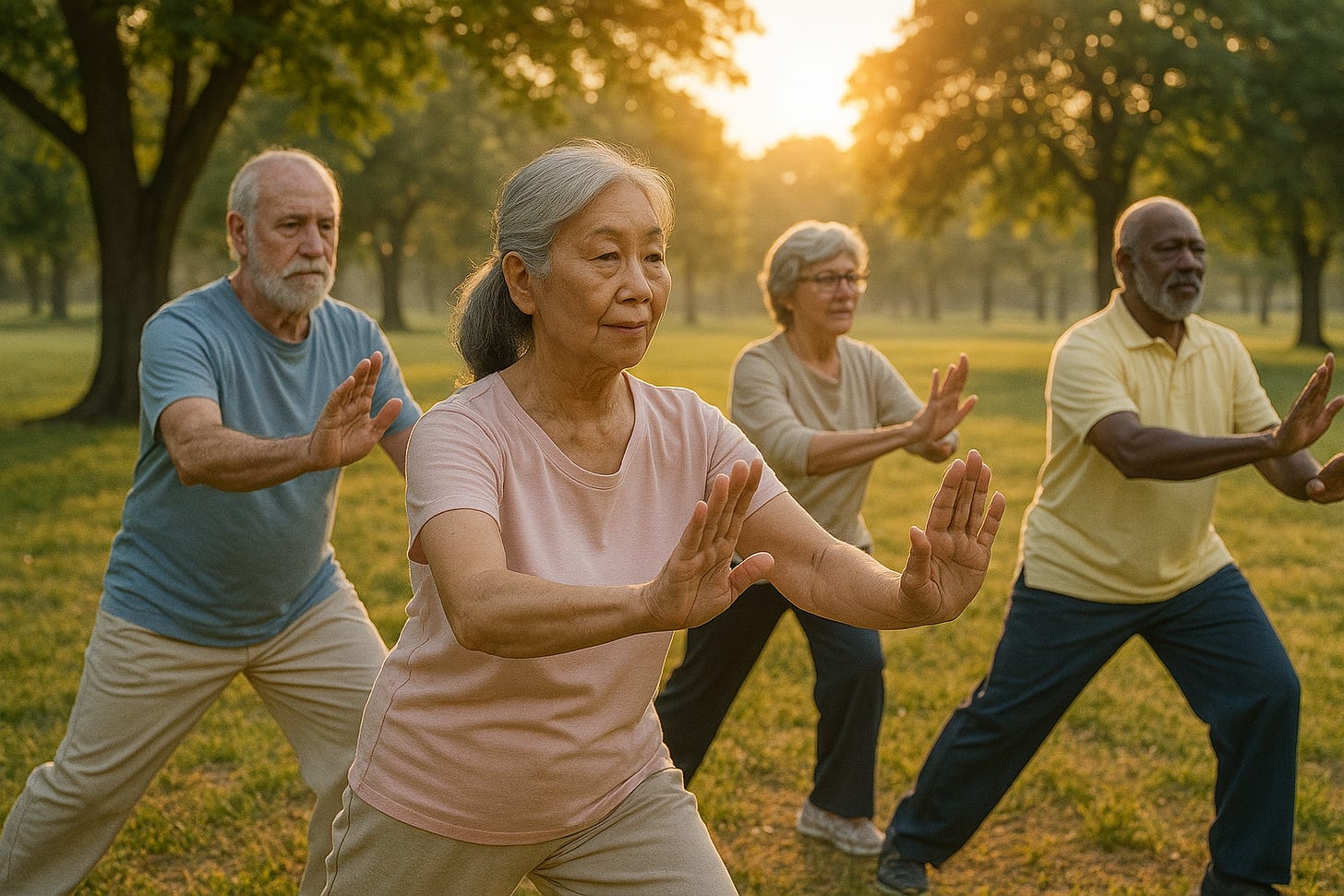A Beginner’s Guide to Tai Chi: Simple Steps for Better Stability at Home
Have you ever stood up too quickly and felt that little wobble — the one that makes you reach for the table and pretend you totally meant to do that? You’re not alone. As we age, even simple movements can feel a little unsteady. But here’s a wonderful truth: balance isn’t something you lose forever. You can train it — calmly, gently, and even beautifully.
That’s where tai chi comes in.
Tai chi is often called “meditation in motion,” and once you try it, you’ll see why. It’s slow, fluid, and deeply relaxing — but don’t let that fool you. Beneath those graceful movements is a powerful workout for your balance, coordination, and peace of mind.
And the best part? You don’t need a gym, fancy outfit, or previous experience. Just a little space, a bit of patience, and a willingness to move slowly and breathe deeply.
What Is Tai Chi?
Tai chi (pronounced tie-chee) began centuries ago in China as a martial art. Over time, it evolved into a gentle form of exercise that strengthens the body while calming the mind.
Instead of fast punches or kicks, tai chi uses slow, controlled movements — like a dance that never rushes. Each movement flows into the next, keeping your body in constant, gentle motion.
Think of it as the opposite of today’s “hustle culture.” There’s no pressure to do more, push harder, or break a sweat. Tai chi asks only that you show up — and in return, it rewards you with balance, energy, and calm.
Why Tai Chi Is Perfect for Seniors
Tai chi checks nearly every box for healthy aging:
✅ Improves balance and reduces falls. Research shows tai chi can lower the risk of falling by as much as 50%.
✅ Strengthens legs and core. Those slow shifts from one foot to the other engage muscles that keep you steady.
✅ Loosens stiff joints. The movements encourage gentle flexibility — no deep stretches or floor work required.
✅ Calms the mind. The deep breathing and rhythm of the motions reduce stress and anxiety.
✅ Improves sleep and focus. Many seniors report sleeping more soundly and feeling sharper mentally after a few weeks of practice.
And unlike some exercises that feel intimidating, tai chi is kind. It meets you right where you are — whether you’re full of energy or feeling a little stiff this morning.
Getting Started: Set the Scene
You can begin tai chi anywhere — your living room, porch, or backyard all work perfectly. Here’s how to create your own peaceful practice space:
Clear the area. Move chairs, rugs, or cords out of the way. You just need a space big enough to take one or two small steps in any direction.
Wear comfortable clothes. Loose, breathable clothing lets your body move easily.
Footwear: Flat, flexible shoes or bare feet are ideal. The goal is to feel grounded.
Set the mood. Soft music, morning sunlight, or even the sound of birds can make your practice more relaxing.
Now, take a deep breath. You’re ready.
The Warm-Up: Finding Your Center
Before you start, let’s ease into motion.
The Centering Breath
Stand tall, feet shoulder-width apart.
Rest your hands gently at your sides.
Inhale through your nose, letting your chest expand slightly.
Exhale slowly through your mouth.
Feel your body relax and your shoulders soften.
Repeat this three or four times until you feel calm and steady. This breath is the foundation of tai chi — slow, mindful, and full of ease.
Simple Tai Chi Moves You Can Do at Home
Let’s start with a few beginner-friendly movements. You don’t need to remember fancy names — just think of them as natural motions your body already knows.
1. The Rocking Motion (Balance Builder)
This move trains your legs and teaches your body how to shift weight smoothly — a key part of staying steady.
Stand with feet hip-width apart.
Shift your weight gently onto your right foot.
Slowly move your weight back to your left foot.
Keep your knees soft, not locked.
Breathe deeply and move slowly — no rushing.
Repeat 10 times, moving like seaweed swaying in calm water.
If you need extra support, lightly rest one hand on a countertop or sturdy chair.
2. Holding the Ball
This movement builds coordination and strengthens your core.
Stand tall. Imagine you’re holding a big beach ball in front of your chest.
Keep your elbows relaxed and rounded.
Shift your weight slightly to the right foot as your right hand lifts the imaginary ball up, left hand down.
Then switch — shift your weight to the left as your left hand lifts and your right lowers.
Continue this slow, flowing exchange 8–10 times.
Imagine you’re moving energy between your hands — calm, circular, and smooth.
3. The Gentle Push (Strength and Posture)
This helps improve upper body strength and posture.
Stand tall with knees slightly bent.
Bring your hands up in front of you, palms facing outward at chest level.
As you exhale, slowly “push” your palms forward — as if pressing away a soft cloud.
Inhale as you bring your hands back toward your body.
Repeat 6–8 times, keeping your shoulders relaxed.
You’ll feel the chest open and the spine lengthen — like standing an inch taller.
Tai chi isn’t about how fast you move — it’s about how deeply you breathe.
4. The Rising Sun
This movement opens your chest, encourages deep breathing, and wakes up your whole body.
Start with your hands at your sides.
Inhale slowly as you raise your arms out to the sides and up over your head, palms facing each other.
Exhale as you lower your arms gently back down.
Try this 5–6 times.
Imagine greeting the day with a calm, grateful heart.
5. Wave Hands Like Clouds
This classic tai chi movement feels beautiful once you find its rhythm.
Step your feet slightly wider than hip-width.
Bend your knees softly and relax your shoulders.
Slowly wave your hands side to side, one high, one low, as if moving clouds across the sky.
Shift your weight gently from one foot to the other.
This is balance training disguised as art. The slow weight shifts build stability in your legs and ankles — crucial for fall prevention.
6. Parting the Horse’s Mane (Confidence Builder)
Don’t worry about the name — just think of it as a graceful side-step.
Hold your “imaginary ball” again, right hand on top.
Step your left foot slightly to the side.
As you shift your weight onto that foot, “part” your hands — left hand moving forward, right hand moving back, like smoothing a horse’s mane.
Return to center and switch sides.
This move improves coordination and focus — plus it feels surprisingly empowering.
How Often Should You Practice?
You don’t need to do tai chi for an hour to see benefits. Even 10 minutes a day can improve your balance and energy.
Start small — maybe just two or three movements a few times a week. Gradually build up as it becomes part of your routine.
And remember, the goal isn’t perfection. It’s progress.
If you lose your place or forget a move, just keep flowing. There’s no “wrong” in tai chi — only movement and breath.
Take It Further: Find a Local Class
While home practice is wonderful, joining a class adds an extra layer of motivation and connection.
Check local:
Senior centers — many offer free or low-cost tai chi sessions.
Community colleges — often have continuing education courses for adults.
Parks & recreation programs — look for outdoor tai chi or “Silver Sneakers” classes.
YMCA or YWCA — usually have gentle movement options for seniors.
A class gives you gentle guidance from an instructor, helps you learn proper form, and adds the joy of moving with others. Many seniors say it becomes the highlight of their week — a peaceful, social hour where they leave feeling both calm and strong.
Common Concerns — and Reassurances
“I can’t remember all the steps.”
You don’t need to! Focus on how it feels, not how it looks. The benefits come from the movement, not the memorization.
“I have arthritis.”
Perfect. Tai chi is one of the safest ways to move stiff joints. Keep your motions small and comfortable.
“I might lose balance.”
It’s okay to hold onto a chair or countertop. Over time, you’ll find yourself needing that support less and less.
“I get bored easily.”
Add variety — play soft music, practice outdoors, or join a friend. The goal is enjoyment, not discipline.
And if your knees crackle like old radio static? Just smile — that’s your body saying, “Hey, I’m waking up again!”
Tai chi doesn’t care how old you are. It only asks you to begin.
💡 Caregiver Corner
If you’re supporting a parent or partner, tai chi can be a wonderful shared ritual.
Try it together. A 10-minute joint session can lift moods and create calm connection — no words required.
Encourage consistency. Even five minutes daily can make a real difference. Gently remind them that small steps count.
Keep it safe. Make sure the practice area is clear, with stable furniture nearby.
Celebrate progress. Notice when balance improves or confidence grows — those small wins matter more than perfection.
✨ Your Turn
Have you ever tried tai chi before — maybe in a class, a park, or at home with YouTube?
We’d love to hear about your experience! What helped you feel more balanced or relaxed?
Share your story in the comments — your tip might be the encouragement another reader needs to begin.
And if you haven’t tried yet, here’s your gentle nudge:
Stand tall. Breathe deeply. Rock side to side.
That’s tai chi — and it might just change how steady you feel every day.




Excellent article and advice. I've been using a free Tai Chi video routine and even 10 minutes a day helps.
I’ve been wanting to learn tai chi, but the written descriptions aren’t clear enough for me to understand what to do. I got as far as Holding The Ball and gave up. I need to look for video tutorials.